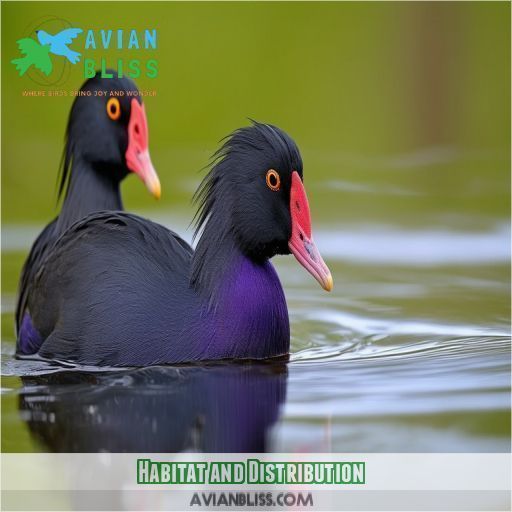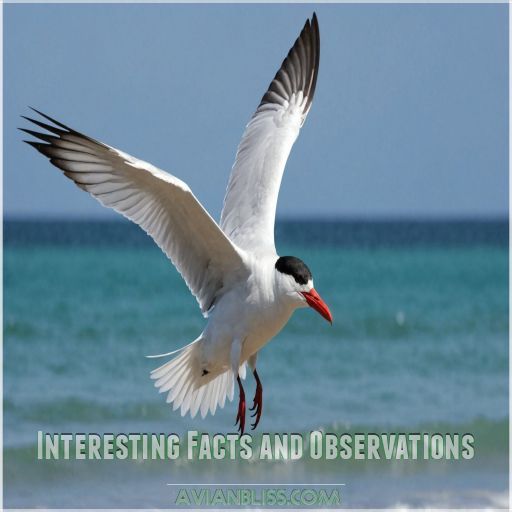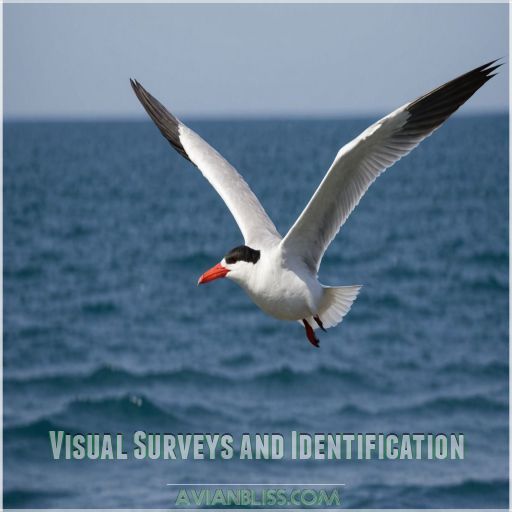This site is supported by our readers. We may earn a commission, at no cost to you, if you purchase through links.

Though found on five continents, the Caspian Tern is no stranger to epic migrations, following seasonal changes and flight corridors.
But this adaptable seabird faces threats like habitat loss and climate change.
Discover the fascinating facts about the Caspian Tern’s physical traits, behaviors, nesting habits, and conservation status – and learn how you can help protect this remarkable bird.
Table Of Contents
- Key Takeaways
- Physical Characteristics
- Habitat and Distribution
- Behavior and Diet
- Nesting and Breeding
- Sounds and Communication
- Conservation Status
- Caspian Tern Vs. Other Tern Species
- Interesting Facts and Observations
- Visual Surveys and Identification
- Frequently Asked Questions (FAQs)
- Where do Caspian terns live?
- What is a fun fact about the Caspian Tern?
- What is the difference between a royal tern and a Caspian Tern?
- What is the difference between arctic tern and Caspian Tern?
- What cultural significance do Caspian Terns hold?
- How do Caspian Terns interact with humans?
- What is the history of Caspian Tern discovery?
- Are Caspian Terns used in scientific research?
- What parasites affect Caspian Terns?
- Conclusion
Key Takeaways
- Caspian Terns are the world’s largest tern species, boasting impressive size, striking red bills, and graceful aerial acrobatics that make them a sight to behold. From their global distribution to their fascinating behaviors, these remarkable birds are true masters of the skies, like the Great Cormorant.
- While Caspian Terns face threats like habitat loss and climate change, their adaptability and resilience are truly inspiring. By understanding their nesting habits, migration patterns, and conservation needs, we can all play a role in protecting these magnificent seabirds for generations to come.
- Caspian Terns are more than just skilled hunters – they’re also clever scavengers and opportunistic thieves, occasionally snatching meals from other birds. Their complex social dynamics, including colony defense and dominance hierarchies, are a testament to their survival instincts.
- Spotting a Caspian Tern is a breeze if you know what to look for – their massive wingspan, distinctive red bills, and confident flight patterns make them stand out. Whether you’re a seasoned birdwatcher or a curious nature enthusiast, observing these avian wonders is a truly rewarding experience.
Physical Characteristics
When you spot a Caspian Tern, you’ll notice it’s no ordinary seabird—their size alone can make you gasp, as they often surpass many gulls in stature!
Caspian Terns are certainly ready for their close-up, even if their winter attire includes a bit of streaky clouding for variety.
With their striking red bills and distinguished black caps, they’re no ordinary seabird.
Size and Measurements
Hydroprogne caspia boasts impressive size and measurements. With 19-23 inches in body length, good luck hiding from these graceful giants.
Plumage Patterns and Coloration
Caspian Terns flaunt striking plumage variations with age-related changes, offering wonderful camouflage against waterbird predators.
Seasonal differences help them adapt within changing marine ecosystems, protecting them against threats like sea-level rise.
Bill Shape and Color
The Caspian tern’s thick, vibrant red bill is a striking feature, aiding in spotting and snatching prey. Its unique shape and color set it apart.
- Bill evolution for efficient prey capture
- Color variation reflects species’ adaptations, like the iridescent or shimmering tails found in some birds
- Bill shape aids in species identification
Head Shape and Crest
Ever wondered why terns look like they’ve hit a windy salon? Their thick red bill and short crest give them an edgy, square-headed charm.
Juvenile and Nonbreeding Plumage
Exploring juvenile plumage, you’ll notice their effective camouflage with grayish brown back markings. Nonbreeding adults show seasonal variations, revealing different age-related plumage differences through molting.
Habitat and Distribution
When you’re exploring where the world’s largest tern hangs out, remember that Caspian Terns aren’t just coastal birdies; they’re quite the globe-trotters.
From nesting on islands with prime beach views to hanging out at lakeside resorts, they’ve mastered the art of living near water on pretty much every continent except Antarctica.
Global Distribution and Range
Across five continents, the Caspian Tern enjoys a cosmopolitan distribution, thriving in:
- Coastal waters
- Large lakes
- Estuaries
- Lagoons
Preferred Breeding and Nesting Sites
Zooming in from the global range, you’d spot Caspian Terns favoring islands and open coastlines. They cleverly select sites with fewer pesky predators.
Coastal and Inland Habitats
Picture your home by the sea or lakeside, without ocean view restrictions; Caspian Terns relish habitat variations that meet food availability and nesting differences.
Migration Patterns and Routes
Caspian Terns set out on an epic journey!
You’ll find them following thrilling migration patterns and routes:
- Seasonal changes inspire movement.
- Flight corridors guide them.
- Stopover locations provide rest.
- Tracking technology reveals secrets.
Wintering Grounds and Southern Limits
After breeding, Caspian Terns head south, wintering along coasts of the West Indies, Central America, and northernmost South America. Climate change may disrupt this pattern.
Behavior and Diet
Get ready to soar with the Caspian Tern as you explore its fascinating hunting skills and diverse diet.
Whether they’re gracefully plucking fish from the water or cheekily stealing meals from other birds, these terns are the ultimate aerial acrobats with a flair for drama!
Foraging and Hunting Techniques
In terms of fish-catching, aerial acrobatics help enormously. Dive-bombing with precision, they execute their prey selection brilliantly. Here are their techniques:
- Hovering before plunging.
- Rapid dive submersion.
- Group hunting coordination.
Primary Food Sources and Prey
You might fancy fish too, but Caspian Terns’ diet variation includes crustaceans and insects, making them the fisher-bird equivalent of foodies.
Scavenging and Kleptoparasitism
Caspian Terns are known to engage in opportunistic scavenging and kleptoparasitism, stealing food from other birds.
- They may chase and force other seabirds to surrender their hard-earned prey.
- Kleptoparasitism allows Caspian Terns to supplement their diet with minimal energy expenditure.
- This behavior can lead to resource partitioning and shifts in prey selection for subordinate species.
- Scavenging and food theft are increasingly recognized as important interspecific interactions for Caspian Terns.
- The costs and benefits of kleptoparasitism are complex, with impacts on both the host and the thief. (Source)
Social Interactions and Aggression
Colony defense is like feathered warriors in territorial disputes.
Chick-guarding and dominance hierarchies play key roles in breeding success. It’s sheer survival instinct!
| Behavior | Description | Impact |
|---|---|---|
| Colony Defense | Protecting group nests | Increases safety |
| Territorial Disputes | Verbal and physical | Determines hierarchy |
| Chick-Guarding | Parental vigilance | Guarantees offspring |
| Dominance Hierarchies | Power structure | Organizes colony |
| Breeding Success | Successful offspring | Continuation of life |
This structure allows for the continuation of life. The colony defense system works together to keep the colony safe.
Mating and Courtship Displays
Within the colony dynamics, watch for the male’s fish-gift ritual. It’s like a culinary courtship dance: "Here’s dinner, want to breed?
Nesting and Breeding
When you peek into the fascinating world of Caspian Terns, you’ll find that their nesting and breeding habits are as interesting as their aerial acrobatics.
Their nests are simple ground scrapes where they lay eggs,
but the family’s teamwork in raising chicks is nothing short of Oscar-worthy!
Colony Structure and Social Organization
Caspian tern colonies range from a few pairs to thousands, with birds fiercely defending their nests and cooperating to raise young, just like cardinals exhibit territorial behavior.
Nesting Sites and Materials
Choosing nesting sites wisely, Caspian Terns prefer open areas for predator defense. They use pebbles, shells, and vegetation for nest materials in colonies.
Egg-Laying and Incubation
Each nest invites a small clutch size of 1-3 eggs; parents share the incubation duration equally, ensuring nesting success with unyielding teamwork.
Parental Care and Fledging
Once the eggs are incubated, watch how parental care supports fledgling development. Chick survival hinges on parental feeding and attention.
- Brood size varies.
- Shared chick duties.
- Youngsters leave nests quickly.
- Parents teach fishing.
Monogamy and Mate Fidelity
Caspian terns often mate for life, with both sexes fiercely guarding their partner during breeding season. Their courtship rituals cement lifelong pair bonds.
Sounds and Communication
You can’t miss the Caspian Tern’s loud "rrrra" call, especially when it’s warning friends with an alarm or staying in touch.
It may look like a grumpy bird, but even its posturing and the softer whistles from females and juveniles add to their fascinating communication repertoire.
Vocalizations and Alarm Calls
Alarm calls and vocalizations express the Caspian Tern’s emotions like a siren song. Experience their soundscape evolution:
- Harsh "rau" calls
- Alarm call variations
- Distress signals
Courtship Displays and Visual Signals
The fish-gift ritual marks the dating scene for terns. Males perform head bobbing, flaunting their plumage. It’s a colorful mating dance that inspires freedom like a seabird’s soaring flight.
Posturing and Agonistic Behavior
Caspian Terns use dramatic posturing and agonistic behaviors to defend their territories, protect their chicks, and compete for food. Their ruffled feathers, raised heads, and loud calls signal dominance and aggression.
- Lateral attacks
- Chasing
- Biting
- Barbering
- Threat displays
Juvenile and Female Vocalizations
Think of juvenile calls as playful chatter, while female courtship brings softer vocal development. These calls, a touch like musical notes, play a key communication role in sound variation.
Conservation Status
Caspian Terns are doing pretty well overall, but like a teen forgetting their lunch money, they face some challenges due to habitat loss and climate change.
With a global population estimated at 530,000, these birds need our attention to help them thrive despite rising sea levels and other threats.
Global Population Estimates and Trends
Monitoring methods reveal a stable population, yet climate impacts could lead to range shifts. It’s a delicate dance balancing conservation challenges and future uncertainties.
Threats and Vulnerabilities
Unfortunately, the caspian tern faces threats like hunting, pesticides, and disturbance to its nesting colonies – challenges we must address to protect this remarkable species. (Source)
Habitat Loss and Degradation
While threats loom like shadows, Caspian Terns face habitat loss due to coastal development and pollution. Habitat restoration and effective conservation strategies are their lifeline.
Climate Change and Sea-Level Rise
With sea-level rise threatening coastal habitats and shifting breeding grounds, Caspian Terns may adapt migration, jokingly trading beach views for cliffside real estate.
Conservation Efforts and Management
Safeguarding Caspian Terns includes habitat restoration and community engagement, tackling climate change impacts, pollution mitigation, and careful population monitoring. Speaking of which, why did the tern bring sunglasses? It couldn’t keep its eyes off the horizon!
- Revitalize nesting areas for thriving colonies.
- Protect against pollution threats and chemical spills.
- Partake in community efforts for awareness.
- Listen to nature’s croaky melodies.
- Embrace change for a greener, bluer tomorrow.
Caspian Tern Vs. Other Tern Species
While the Caspian Tern may share some similarities with other tern species, it has a few distinct features that set it apart.
From its massive bill to its unique hunting tactics, this impressive seabird has carved out its own niche in the avian world.
Comparison With Royal Tern
When you’re understanding Caspian and Royal Terns, focusing on size and distribution highlights differences.
Check out their distinct traits, from nesting behavior to diet, in their foraging habits:
| Feature | Caspian Tern | Royal Tern |
|---|---|---|
| Size | Largest tern species | Second biggest tern |
| Distribution | Cosmopolitan | Tropical shores |
| Diet | Primarily fish, some insects | Fish and crustaceans |
Comparison With Arctic Tern
Imagine a Caspian Tern and an Arctic Tern squawking over migration patterns! You’ll find distinct breeding ranges and diet differences, but both share nesting habits and a conservation status.
Key Identification Features
Spotting a Caspian Tern is a breeze! Look for these identifiers:
- Bold red bill color,
- Distinctive wing patterns,
- Streaky head markings in juveniles.
Behavioral and Ecological Differences
The Caspian Tern’s massive size and aggressive foraging tactics set it apart from its smaller, more graceful tern cousins. Its adaptations allow it to thrive in diverse habitats.
| Trait | Caspian Tern | Royal Tern | Arctic Tern |
|---|---|---|---|
| Size | Largest tern | Medium-sized | Smallest tern |
| Foraging | Plunge dives, steals prey | Hovers, dips for fish | Skims water, snatches prey |
| Nesting | Open ground colonies | Isolated pairs | Dense colonies |
| Migration | Shorter, coastal | Longer, transequatorial | Longest, circumpolar |
Interesting Facts and Observations
As you learn about Caspian Terns, you’ll be amazed by their unique adaptations that make them superb fliers and effective hunters.
These remarkable birds even manage to make thievery look fashionable, occasionally snatching a meal from less fortunate feathered friends.
Unique Characteristics and Behaviors
Moving from comparisons, let’s highlight their long life span, fish-stealing tactics, and colony dynamics.
Caspian Terns’ aerial acrobatics and clever nesting strategies make them the savvy sky pirates of avian communities.
Adaptations and Specializations
Caspian Terns excel in diving technique.
With impressive bill adaptations and prey specialization, Caspian Terns excel in diving technique.
Their soaring flight aids in colony defense.
These birds are the airborne, fish-snatching marvels of the water world!
Interesting Behaviors and Interactions
Caspian Terns often boldly steal fish from other birds, engaging in lively colony dynamics. Their impressive courtship rituals and fierce nest defense tactics are truly fascinating to observe during the mating process.
Cultural Significance and Symbolism
Diving into fascinating behaviors, you’ve entered a world where folklore and mythology paint vivid pictures of freedom and grace.
In art and literature, these birds symbolize:
- Elegance
- Strength
- Mystery
- Freedom
Visual Surveys and Identification
To spot a Caspian Tern, keep an eye out for its striking red bill and distinctive black cap.
Remember, this bird’s massive wingspan and graceful flight are hard to miss, just like someone waving at you from across the room!
Field Identification Tips and Tricks
Unravel the mystery of terns by spotting their distinctive red bill and wingspan in flight. Juvenile plumage often adds intrigue. Compare habitat clues to similar species for accuracy!
Visual Surveys and Monitoring Methods
Conducting visual surveys and monitoring Caspian Tern colonies can shed light on population trends.
Try mapping nesting sites, checking the quality of their habitat, and getting involved in citizen science projects.
- Map nesting colonies
- Monitor breeding success
- Check the quality of their habitat
- Participate in citizen science
- Track population changes
Photography and Observation Techniques
When out photographing Caspian Terns, make sure your camera settings match the lighting conditions. Bring field guides; it’s like having a bird mentor in your pocket. Observe ethically, respecting nature.
| Tips | Description | Humor Addition |
|---|---|---|
| Camera Settings | Adjust for brightness and clarity | "No auto-pilot allowed!" |
| Field Guides | Handy for bird identification | "Bird nerd’s best friend!" |
| Lighting | Best during early morning or late afternoon | "Shadows shouldn’t steal the show!" |
| Ethical Practices | Respect nature; don’t disturb wildlife | "Crowd-pleasing, not crowd-releasing!" |
Important Features for Identification
Spotting a Caspian Tern is a cinch if you know their wingspan stretches wide, while their bill shape and head markings create a striking profile. Watch their confident flight pattern.
Frequently Asked Questions (FAQs)
Where do Caspian terns live?
You’ll find these globe-trotting Caspian Terns along coastlines and large inland waters worldwide, except Antarctica.
They adore bays, lagoons, rivers, and lakes, nesting in flat, open spots.
Migration takes them south to warmer regions after breeding.
What is a fun fact about the Caspian Tern?
Did you know Caspian Terns are the largest tern species, even bigger than many gulls?
With their striking red bills and fish-catching antics, they’re like the high-flying acrobats of the bird world, bringing a splash of excitement.
What is the difference between a royal tern and a Caspian Tern?
While both the royal tern and Caspian tern are large coastal birds, the Caspian tern is much larger, with a thicker red bill and a squarer head.
Plus, the Caspian tern‘s black cap extends to its eyes.
What is the difference between arctic tern and Caspian Tern?
Think of the Arctic Tern as the marathon runner of birds, migrating longer distances than anyone.
They’re smaller than the chunky Caspian Tern, with dainty red bills, sleek bodies, and a palette of cold, bluish-gray tones.
What cultural significance do Caspian Terns hold?
Like stealthy jet pilots of the skies, Caspian Terns rarely feature prominently in folklore.
Instead, you’ll find them symbolizing freedom and the untouched wilderness, gliding across waters fittingly dubbed "Caspian" for their boundless hunting territories.
How do Caspian Terns interact with humans?
Caspian Terns interact with humans as aggressive defenders of their breeding colonies, occasionally chasing people.
They’re indicators of healthy aquatic environments and face threats from human activities like habitat loss, pollution, and climate change (Source).
What is the history of Caspian Tern discovery?
Imagine stumbling upon a rare bird species – it’s like discovering a hidden gem!
The Caspian Tern, once obscure, is now celebrated worldwide thanks to dedicated naturalists who uncovered its fascinating history and unique adaptations over time.
Are Caspian Terns used in scientific research?
You’d be surprised how Caspian Terns are pivotal in scientific research!
They’re monitored for foraging behavior via GPS telemetry, which is like a bird’s own Google Maps.
This advances understanding of these majestic seabirds’ habits and conservation needs.
What parasites affect Caspian Terns?
Picture a bustling city of feathers plagued by unwelcome hitchhikers.
Feather lice and parasitic worms sneakily sap the energy of their hosts.
It’s like having tiny stowaways that drain energy without pitching in on rent!
Conclusion
Like the Caspian Tern’s soaring flight, your understanding of this striking bird can reach new heights.
With its striking red bill and fascinating behaviors, the Caspian Tern enchants both birdwatchers and conservationists.
Despite its beauty, it faces challenges like habitat loss and climate change.
By learning more about the Caspian Tern, you’re part of the solution, ready to protect this remarkable species for future generations.
Spread your wings like the tern and take action today!












